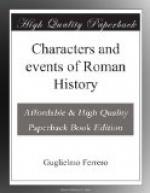Surely he first shed Christian blood; but if we consider the tendency he represented in Roman history, we can hardly classify him among the great enemies of Christianity. Unwittingly, Augustus and Tiberius were two great enemies of the Christian teachings, because they sought by all means to reinforce Roman tradition, and struggled against everything that would one day form the essence of Christianity—cosmopolitism, mysticism, the domination of intellectual people, the influence of the philosophical and metaphysical spirit on life. Nero, on the contrary, with his repeated efforts to spread Orientalism in Rome, and chiefly with his taste for art, was unconsciously a powerful collaborator of future Christian propaganda. We must not forget this: the masses in the Empire became Christian only because they had first been imbued with the Oriental spirit.
Nero and St. Paul, the man that wished to enjoy all, and the man that suffered all, are in their time two extreme antitheses: with the passing of centuries, they become two collaborators. While one suffered hunger and persecution to preach the doctrine of redemption, the other called to Italy and to Rome, to amuse himself, the goldsmiths, weavers, sculptors, painters, architects, musicians, whom Rome had always rebuffed.
Both disappeared, cut off by the violent current of their epoch; centuries went by: the name of the Emperor grew infamous, while that of the tent-maker radiated glory. In the midst of the immense disorder that accompanied the dissolution of the Roman Empire, as the bonds among men relaxed, and the human mind seemed to be incapable of reasoning and understanding, the disciples of the saint realised that the goldsmiths, weavers, sculptors, painters, architects, and musicians of the Emperor could collect the masses around the churches and make them patiently listen to what they could still comprehend of Paul’s sublime morality. When you regard St. Mark or Notre Dame or any other stupendous cathedral of the Middle Ages, like museums for the work of art they hold, you see the luminous symbol of this paradoxical alliance between victim and executioner.
Only through the alliance of Paul and Nero could the Church dominate the disorder of the Middle Ages, and, from antiquity to the modern world, carry through that formidable storm the essential principles from which our civilisation developed: a decisive proof that, if history in its details is a continuous strife, as a whole it is the inevitable final reconciliation of antagonistic forces, obtained in spite of the resistance of individuals and by sacrificing them.
Julia and Tiberius
“He walked with head bent and fixed, the face stern, a taciturn man exchanging no word with those about him.... Augustus realised these severe and haughty manners, and more than once tried to excuse them in the Senate and to the people, saying that they were defects of temperament, not signs of a sinister spirit.”




